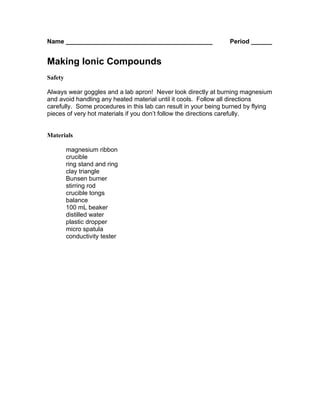
Making Ionic Compounds Lab
- 1. Name __________________________________________ Period ______ Making Ionic Compounds Safety Always wear goggles and a lab apron! Never look directly at burning magnesium and avoid handling any heated material until it cools. Follow all directions carefully. Some procedures in this lab can result in your being burned by flying pieces of very hot materials if you don’t follow the directions carefully. Materials magnesium ribbon crucible ring stand and ring clay triangle Bunsen burner stirring rod crucible tongs balance 100 mL beaker distilled water plastic dropper micro spatula conductivity tester
- 3. Lab 1. As in any lab, make sure all utensils are clean (utensils include: crucible, stirring rod, 100 mL beaker, plastic dropper, and micro spatula). Also check for cracked glass. 2. Arrange the ring on the ring stand so that it is about 7 cm above the Bunsen burner. Place the clay triangle on the ring. 3. Measure the mass of the clean, dry crucible and record the mass in the data table. 4. Roll approximately 25 cm of magnesium ribbon into a loose ball and place it in the crucible. Measure the mass of the ball and the crucible and record it. 5. Place the crucible on the clay ring. Heat with a hot flame making sure that the crucible is near the top of the flame. Danger! Do not look at the bright light directly! It will permanently damage your eyes! 6. Watch carefully! When the metal ignites, move the Bunsen burner out from under the crucible and clay triangle, and turn off the flame. Caution! Follow these directions carefully! The crucible can shatter, sending hot pieces of material flying. 7. After everything has stopped reacting, wait a couple of minutes for the crucible to cool slightly. Then take a plastic dropper and very carefully place one drop of water along the inside top edge of the crucible. Allow the drop of water to roll down the inside of the crucible and come in contact with the magnesium products in the bottom. Continue to add drops of water in this manner until the water no longer sizzles. 8. Re-light your burner and reheat the crucible with the magnesium product and water until all the water has been boiled off. 9. Turn off the Bunsen burner and allow the crucible to cool. After a few minutes measure and record the mass. 10. Use a micro spatula to scrape the solid magnesium product into a beaker for further testing.
- 4. 11. Add 10 mL of distilled water to the beaker and stir. Pour the contents of this beaker into the large beaker with everyone else’s. Check with a conductivity tester and record your results. 12. Return all lab equipment to its proper place. 13. Complete all Questions. Data Table Material(s) Mass (g) Empty crucible Mg ribbon and crucible (together) before heating Magnesium ribbon Magnesium products and crucible (together) after heating Magnesium product Questions 1. Calculate all masses and record them in the table. a) Write the electron configuration for magnesium. • Based on the configuration, will magnesium lose or gain electrons to become a magnesium ion? • Write the electron configuration of a magnesium ion. • What noble gas has the same configuration as magnesium ion? b) Repeat a) above for oxygen and nitrogen.
- 5. c) What kind of energy was released during the reaction? What can you conclude about the product of this reaction? d) How do you know that the magnesium reacts with certain components of air? e) Magnesium reacts with oxygen and nitrogen in the air at high temperatures. Predict the binary formulas for the products. Write the names of these compounds. f) The product of the magnesium and oxygen is white and the product of magnesium and nitrogen is yellow. Which one dominates your product? g) Did the product produce an electric current? Does this indicate whether or not the compounds are ionic?